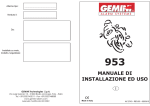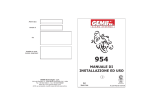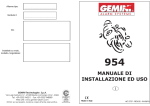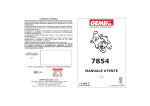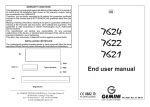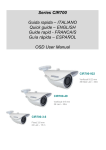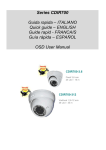Download INSTALLATION AND USE MANUAL
Transcript
System type: ........................................................................... Sold on: ........................................................................... By: Installed on bike model, number plate/frame: 953 INSTALLATION AND USE MANUAL UK GEMINI Technologies S.p.A. Via Luigi Galvani 12 - 21020 Bodio Lomnago (VA) - Italia Tel. +39 0332 943211 - Fax +39 0332 948080 Web site: www.gemini-alarm.com NOTE: please send a copy to the insurance company if secessay. For all EU Countries AC 2743/UK-REV.00- 01/10/08 UK CONTENTS 1.0 - PRELIMINARY ADVICE USER MANUAL 2.0 - ALARM SYSTEM CONTROL DEVICES DESCRIPTION 2.1 - Remote control 2.2 - Electronic key 3.0 - SYSTEM OPERATION WITH BASIC CONFIGURATION 3.1 - Arming 3.2 - Trunk open or seat lifted-up signalling 3.3 - Neutral time 3.4 - Siren exclusion 3.5 - Shock sensor exclusion 3.6 - Armed condition 3.7 - Alarm 3.8 - Limiting the acoustic signal 3.9 - Neutral time between two alarm signals 3.10 - System disarming without alarm memory 3.11 - System disarming with alarm memory 4.0 - EXTRA FUNCTIONS DESCRIPTION 4.1 - Acoustic and optic signalling 4.2 - Remote controlled panic alarm 4.3 - Shock sensor 4.4 - Passive arming 4.5 - Anti-hijacking function 4.6 - Pre-alarm 4.7 - System self-rearming 5.0 - SLEEP MODE ACTIVATION/DEACTIVATION 6.0 - HAZARD SIGNALLING 7.0 - USE AND MAINTENANCE 8.0 - SYSTEM UNLOCK PROCEDURE BY PIN-CODE 9.0 - EXAMPLE OF SYSTEM UNLOCK BY PIN-CODE 10.0 - EXAMPLE OF PIN-CODE PERSONALIZATION 11.0 - REMOTE CONTROL BATTERIES REPLACEMENT 12.0 - WASTE ELECTRICAL AND ELECTRONIC EQUIPMENT (WEEE) DIRECTIVE 13.0 - WARRANTY CONDITIONS CONTENTS INSTALLER MANUAL 14.0 - INSTRUCTIONS FOR ALARM SYSTEM INSTALLATION 15.0 - TECHNICAL DATA 16.0 - CONTROL UNIT POSITIONING 17.0 - ACCESSORIES POSITIONING 17.1 - Receptacle for electronic key and LED 17.2 - Perimetral push-button (optional) 18.0 - CONTROL UNIT SEALING 19.0 - SUMMARY REPORT FOR THE ELECTRICAL CONNECTIONS 20.0 - ELECTRIC DIAGRAM 21.0 - ENGINE IMMOBILISATION CONNECTING DIAGRAM (ground wire) 22.0 - ENGINE IMMOBILISATION CONNECTING DIAGRAM (cut wire) 23.0 - EXAMPLE OF ENGINE IMMOBILISATION CONNECTION WITH SPECIFIC WIRING HARNESS 24.0 - ELECTRICAL CONNECTIONS WITH SPECIFIC WIRING HARNESS 24.1 - Engine immobilisation connections 24.2 - Turn signals connections 24.3 - Ground connection 24.4 - Receptacle for electronic key with built-in LED 25.0 - INSTRUCTION FOR DIODE APPLICATION 26.0 - LEARNING OF NEW DEVICES (with ground wire) 27.0 - LEARNING OF NEW DEVICES (without ground wire) 28.0 - EXTRA FUNCTIONS PROGRAMMING 29.0 - EXAMPLE OF PROGRAMMING 30.0 - SHOCK SENSOR ADJUSTMENT 31.0 - EXAMPLE OF SHOCK SENSOR ADJUSTMENT 1.0 - PRELIMINARY ADVICE Dear Customer, the present manual illustrates the top version of the alarm system; not all functions, electrical connections etc. will therefore apply to all models. Before installing, you must identify your alarm model and refer to it for the correct instructions. 953: Nr. 2 remote control, Nr. 1 electronic key and self-powered. 953.02: Nr. 2 remote control, joint LED and self-powered. 952: Nr. 2 remote control, joint LED and not self-powered. The following signs, intended for the installer or the user, indicate particular functions or connections as follows: ! WARNING It shows a real risk of severe damages to the vehicle and to its alarm system in case these instructions are not complied with. CAUTION It shows a risk of damages to the system or of any operative malfunctions of the system in case these instructions are not complied with. We also recommend you to always wear your crash helmet, keep lights on and observe the speed limit, when riding your motorbike. Enjoy your reading… and have a nice trip! USER MANUAL 2.0 - DESCRIPTION OF ALARM SYSTEM CONTROL DEVICES In order to use the alarm system, it needs to receive commands by the user; this can be done by means of remote controls and electronic keys. A further possibility to deactivate the system, when needed, is given by the PIN-CODE. Such procedure can be activated by means of the ignition key of the vehicle itself and is detailed in the relevant chapter. 2.1 - REMOTE CONTROL The remote control is the main user “interface”; therefore, we recommend you to acquaint yourself with it. The remote control buttons activate several functions that differ according to the operational condition and the alarm program. Please also note that buttons have been made different in form, in order to be better recognized and identified. The alarm activation/deactivation button is dotted, while the siren button is smooth. To prevent problems with the remote control, it has been provided with a device that will signal the charge condition of the batteries inside. During normal use of the remote control, when you press a command button the green transmission LED will light up with a steady light. If the battery charge drops below the level needed to assure correct operation of the remote control, when you press a command button the green transmission LED will blink, advising you that it is time to replace the batteries. Button Nr.1: !Alarm system arming/disarming. !Anti hijacking function activation. Button Nr.2: !Hazard function activation. !Anti hijacking function activation. !Panic alarm activation/deactivation. !Siren control during alarm conditions. !Siren control during system activation. !Shock sensor programming, and regulation. Signalling LED Button N.1 Button Nr.2 2.2 - ELECTRONIC KEY The electronic key can be considered a kind of “simplified remote control”. As a matter of fact, in emergency situations (e.g. a failure in the remote control), it can activate and deactivate the alarm, or activate and deactivate the anti-hijacking function (if previously programmed). To use the electronic key, simply put it on the receptacle, and join the metallic contacts. The receptacle also incorporates the alarm system status LED. Electronic key Example of receptacle positioning on the vehicle plastic side cover. 3.0 - SYSTEM OPERATION WITH BASIC CONFIGURATION 3.1 - ARMING Pressing the (dotted) button #1 on the remote control or inserting the electronic key into the receptacle will activate the system. This action is indicated by one long flashing of the turn signals, two short acoustic signals and the permanent turning on of the LED. 3.2 - TRUNK OPENED OR LIFTED-UP SEAT SIGNALLING During alarm system activation, should the seat or the trunk be opened, the system will signal the failure by means of a low-tone signal after the alarm arming signalling. In any case the system will be activated and, at the end of the “neutral time”, an alarm condition will be generated. 3.3 - NEUTRAL TIME When the activation signals are finished, the system goes in standby or neutral-time condition, which is signalled with a steady-light LED. This time duration is about 20 seconds. The engine immobilization function and the connectors for optional modules are already active. 3.4 - SIREN EXCLUSION During the first 4 seconds of neutral time, the alarm siren can be deactivated, by simply pressing (smooth) button N. 2 on the remote control (obviously after N. 1 remote control push-button pressure, system arming). Siren exclusion will be signalled by a short flashing of the turn signals. CAUTION When the siren is excluded, the alarm signals will be changed; indeed only visual signals will be active, i.e. with flashing of the turn signals, but the engine immobilization function will still work. The siren sound exclusion is bound to the single arming cycle. Electronic key Example of receptacle positioning on the vehicle dashboard. 3.5 - SHOCK SENSOR EXCLUSION During the first 4 seconds of neutral time, it is possible to exclude the built-in shock sensor functionning. To do this, you must just put the electronic key into the specific receptacle, after the alarm system has been activated. The exclusion is bound to a single arming cycle and will be indicated by a short flashing of the status LED. 3.6 - ARMED CONDITION At the end of the neutral time, after about 20 seconds, the alarm system goes in the armed condition and signals this with a blinking LED. From now on, the system is ready to signal possible attempts to force the vehicle. 3.10 - SYSTEM DISARMING WITHOUT ALARM MEMORY Pressing the button N.1 (dotted) on the remote control or inserting the electronic key in the receptacle will deactivate the system. The alarm system will signal this change of status with the LED switched off, three beeps and three flashes of the direction indicators at the same time. 3.7 - ALARM If, during the armed condition, should occur any theft attempt against the vehicle, the alarm system will signal this by activating the high-volume siren, lighting up the red LED with a steady light and causing the direction indicators to flash repeatedly for about 30 seconds. The alarm may be activated by different causes (which also depend on the activated functions) described below: !Cut-off of the power supply cables. !Turn on the ignition key (positive under key). !Shock. !Seat/trunk opening (if the protection push-button has been installed). !Panic alarm, by pushing button N. 2 (smooth) on the remote control. When the alarm conditions are over, the system will revert to the armed condition. During the alarm condition it is still possible to deactivate the siren sound and the turn signals flashes by pushing button N. 2 (smooth) on the remote control (without disarming the alarm). 3.11 - SYSTEM DISARMING WITH ALARM MEMORY If during the armed period attempts have been made to force the vehicle, during the deactivation stage the alarm will signal the event with two flashes of the turn signals and, simultaneously, with two low-tone beeps. The last cause of alarm will be signalled with one or more flashes of the turn signals and a corresponding number of beeps, according to the type of event, like indicated in the table below. 3.8 - LIMITING THE ACOUSTIC SIGNALS Alarm conditions caused by shock, displacement, seat/trunk opening or ignition key will be signalled by the activation of the siren for 7 times for each cause. From the eighth alarm condition on, the siren will cease to be active. This deactivation of the siren is performed because of these simple reasons: !Observance of the regulations in force in the subject of acoustic emissions caused by vehicle alarms. !Power saving to maximize the vehicle battery. !It is no use keeping the alarm on if, after 7 acoustic signals, nobody is coming to check the vehicle. !Noise pollution reduction, to prevent penalties as per the regulations in force. 3.9 - NEUTRAL TIME BETWEEN TWO ALARM SIGNALS Once the alarm cycle is over, the device will ignore any other alarm cause for 5 seconds, while keeping the LED steadily on During the neutral time between alarm signals, it is possible disarming the system by PIN CODE, like as described in the relative chapter. Shock sensor alarm: Starting attempt alarm: Trunk open or lift-up seat alarm: Cut wires alarm: 4.0 - DESCRIPTION OF THE EXTRA FUNCTIONS 4.3 - SHOCK SENSOR The table below shows the programmable functions. The manufacturer supplies the system with some of these functions disabled (in order to achieve a good trade-off between ease and completeness of use), being the shock sensor regulated at the minimum of the sensibility. The system may generate an alarm condition caused by a shock or a shifting of the vehicle. The shock sensor is buil in the alarm and is adjustable. Factory setting Function Acoustic signals Panic alarm Shock sensor Passive arming Anti-hijacking procedure Pre-alarm System self-rearming Status Enabled Enabled Enabled Disabled Disabled Disabled Disabled 4.1 - ACOUSTIC AND OPTIC SIGNALLING In the different usage conditions, the alarm system signals the current operation or the alarm memory. This is done using the turn signals an the LED for the optical signals and using the siren for the acoustic signals (the last one can be disabled). FUNCTIONNING During the stages of activation, deactivation, alarm memory, function programming and learning of new devices, the alarm will produce specific acoustic and optic signals in order to show which function is being run. Optic signallings concern either LED or turn signals. The acoustic signals can be high-tone or low-tone. 4.2 - REMOTE CONTROLLED PANIC ALARM It allows to generate an alarm condition by pressing button N. 2 (smooth) on the remote control. The panic signals can be as many as desired, but a minimum 5-second interval must occur between two consecutive signals. FUNCTIONNING Pressing button N. 2 on the remote control will activate the siren and the direction indicators for about 30 seconds. To deactivate the panic alarm, just press again button N. 2 on the remote control. This alarm signalling can be activated indifferently of the system status (activated/deactivated). FUNCTIONNING In armed state, if the vehicle is hit or shifted, the sensor included in the alarm system will detect this anomaly and generate an alarm. 4.4 - PASSIVE ARMING This function allows the user to leave the vehicle sure that the alarm system protection arms itself automatically. FUNCTIONNING Once the engine is switched off, the system automatically activates the passive arming. This will be signalled by one turn signals flash, two LED flashes and two siren high-tone beeps After 35 seconds the system will activate steadly, signalling the operation with a single flash of the turn signals, two acoustic signal and the lighting up of the LED (with a steady light). The procedure can be interrupted, by turning on the ignition switch within 35”. If the trunk or the seat are open, the passive arming time will be interrupted, until the trunk or the seat closing. 4.5 - ANTI-HIJACKING FUNCTION This function ensures a sort of protection against criminals when a theft attempt happens while the vehicle is in use. The function indeed allows to activate the system while stopping the vehicle with the ignition key switch on and the engine running. FUNCTIONNING With the ignition key switch on, it is possible to activate the anti-hijacking function in the following ways: !By pressing button N. 1 on the remote control. !By pressing button N. 2 on the remote control. !By inserting the electronic key in the receptacle. CAUTION The activation of the anti-hijacking function will be signalled by the system with two rapid flashes of the turn signals and a steady LED. Once enabled the anti-hijacking function, the remote controls won’t work anymore. 20 seconds after the activation, the system will immobilize the vehicle’s engine; two seconds later the siren will be activated at high volume and the direction indicators will start blinking repeatedly. This signalling will continue for a minute and, after this time, the siren will be deactivated; the turn signals will continue blinking until the anti-hijacking function is disabled. To deativate the function insert the electronic key in the receptacle. 4.6 - PRE-ALARM In alarm condition, this implies the activation of the siren for just 2,5 seconds (first 3 alarm cause only) rather than the standard 30 seconds. This considerably reduces power consumption while preserving the vehicle's battery, and it reduces the environmental acoustic pollution. FUNCTIONNING When the system is activated, providing an alarm condition is generated (i.e. the vehicle is accidentally hit), the siren will be activated for about 2,5 seconds. This condition of pre-alarm will be activated for the first 3 alarm causes. Indeed, from the fourth cause on, the siren will be activated for about 30 seconds. The alarm cycles will be reset every time the alarm is deactivated or when the panic alarm is activated. 4.7 - SYSTEM SELF-REARMING This function protects the vehicle in case the system would be unintentionally deactivated. FUNCTIONNING The system is activated by the user, then unintentionally deactivated (e.g. the relevant button on the remote control is pressed). The user, unconscious about this, will leave the vehicle unprotected, although being sure of the contrary. 35 seconds after this unintentional deactivation, the alarm will automatically reactivate, signalling this with the standard acoustic and optical signals. 5.0 - SLEEP MODE ACTIVATION/DEACTIVATION When the vehicle is not used, it is possible to switch completely off the alarm system (sleep mode) in order to reduce the battery charge consumption. To activate this function, proceed as follows: !Turn the ignition key to “ON” position; the LED will light for about one second. !After the LED flash put the electronic key into the receptable, within 4 seconds; an acoustic signal will indicate that the system is turned off. !Turn the ignition key of the vehicle to “OFF” position. !To re-activate the alarm, turn the ignition key of the vehicle to “ON” and “OFF”. 6.0 - HAZARD SIGNALLING The hazard signalling is useful when you want to park the vehicle, being the vehicle engine off and the turn signals on. To activate/deactivate this function, proceed as follows: !Switch off the engine, by turning the ignition key of the vehicle to “OFF”. !Turn the ignition key to “ON” position; the LED will light for about one second. !During this period, push the button N.1 of the remote control. !Turn the ignition key to “OFF”; the turn signals will start flashing. !To deactivate the turn signals flashing you must just turn again the ignition key to “ON” (and eventually to “OFF”), or arm and disarm the system. 7.0 - USE AND MAINTENANCE Please note that the alarm system is still an electronic device, so must be handled carefully. The following are simple hints which are useful if you want to prevent device damage because of an improper use. !Do not clean the control unit with water but only use a damp cloth. !Do not use power supply voltages which are different than those specified by the factory. !If the motorbike is cleaned with a washing machine, be careful not to directly expose the alarm system to the water jets. ! WARNING Gemini Technologies S.p.A. is not responsible for damages to the system in case of an improper use of it. 8.0 - UNLOCK PROCEDURE BY PIN-CODE 9.0 - EXAMPLE OF SYSTEM UNLOCK BY PIN-CODE The PIN-CODE procedure allows deactivating the alarm system in case of emergency, that is to say when, for any reason whatsoever, the remote control or the electronic key cannot be used. To have the system deactivated, the final user shall “communicate” a four-digit numeric code to the system, originally set up by the manufacturer as 1-1-1-1. Due to obvious safety reasons, we recommend to replace this original code with another user’s customized code. Please see next pages to carry out this operation, than read the instructions below to unlock the alarm with the PIN-CODE: !Cause an alarm situation; as soon as the alarm condition is finished, the installed LED will turn on and stay fixed for about 5”. !While the LED is on with a fixed light, switch “ON” and “OFF” the ignition key switch. To better understand the alarm system unlock by means of PIN-CODE, please refer to the following example considering the case of a PIN-CODE formed by these digits: 2-3-4-1. CAUTION If during this phase, the ignition key switch is kept connected for more than 5”, the system will read this as a theft attempt, so causing another alarm condition. !The installed LED will turn off so showing the beginning of the unlock procedure. !After 4” from the LED turning off, it will start flashing for 9 blinks. !As soon as the number of blinks is equal to the first digit of the PIN CODE, switch on and off the vehicle ignition key, so confirming the first digit of the code. !After 4”, the LED will start flashing for 9 blinks again. !As soon as the number of blinks is equal to the second digit of the PINCODE, connect and disconnect the ignition key switch, so confirming the second digit of the code. !Repeat the same as above for the remaining two digits to be entered. !As soon as the last digit is stored, the system will be deactivated by signalling this operation as shown in the paragraph ”system disarming with alarm memory” . CAUTION In case the LED blinks exceeds the number of 9, this procedure will fail and this will be read as a theft attempt. After the system is armed, wait for the end of “neutral time” and then cause an alarm condition. Key in “ON” position An alarm condition will occur Key in “OFF” position As soon as the alarm condition is finished, the installed led will turn on and stay fixed for about 5” While the LEED is on, connect and disconnect the ignition key. The LED will turn off showing the beginning of the unlock procedure by means of PIN-CODE. LED fixed on for about 5”. LED turned off. Unlock procedure starts Key in “OFF” position. Key in “ON” position. After 4” from the LED turning off, it will start blinking. As soon as the number of blinks is equal to the first digit of the PIN-CODE (which is 2 in this case), connect and disconnect the ignition key switch. After another 4”, this LED will start blinking again. As soon as the number of blinks is equal to the second digit of the PIN-CODE (which is 3, in this case), connect and disconnect the ignition key switch. 4 Sec. 4 Sec. First digit: “2” “ON” “OFF” Second digit: “3” “ON” “OFF” After 4 seconds, the system restarts counting to set up the other following two digits (which are 4 and 1 in this case). 4 Sec. 4 Sec. Third digit: “4” “ON” “OFF” Fourth digit: “1”“ON” “OFF” As soon as the fourth digit of the PIN-CODE is entered, the alarm system will be deactivated by showing the last alarm cause. 10.0 - EXAMPLE OF PIN-CODE PERSONALIZATION To better understand how to set up the PIN-CODE, please refer to the example below. The following customized PIN-CODE 2-3-4-1 will be entered. Push both remote control buttons at the same time. The LED will go off. LED off Turn off the alarm system. Connect the BROWN/GREEN wire to ground. Turn the ignition key in “OFF” position. Open the saddle of the vehicle if the safety button is fitted. Key in “OFF” position BROWN/GREEN After four seconds have passed, the LED will begin a series of nine flashes. Turn the ignition key in “ON” when we intends to memorize the first figure of the new PIN-CODE. NEGATIVE Turn the ignition key in “ON” position. Key in “ON” position Key in “ON” position The LED installed on the vehicle will light up for one seconds During this time period, press both buttons on the remote control. The system will emit two acoustic signals and then it will light the LED. Boop Boop 0.5 Sec. Remove from negative the BROWN/GREEN wire. After four seconds have passed, the LED will begin a new series of nine flashes. Repeat the operations described above to insert the second number. Fixed light Close the saddle of the vehicle if the safety button is fitted. LED off Key in “OFF” position Key in “ON” position LED off Key in “OFF” position Repeat the same operations described above to insert the other two numbers. When you have finished inserting the fourth number of the PIN-CODE, the system will automatically exit the procedure and it will confirm the termination with two low tone acoustic signals and one high tone signal. BROWN/GREEN Last number NEGATIVE Key in “ON” position Key in “OFF” position Boop Boop Beep 11.0 - REMOTE CONTROL BATTERIES REPLACEMENT The remote control operates using alkaline batteries. Under normal use conditions of the remote control these will gradually lose their charge. The more you use the remote control, the sooner the batteries will become discharged. To prevent problems with the remote control, it has been provided with a device that will signal the charge condition of the batteries inside. During normal use of the remote control, when you press a command button the green transmission LED will light up with a steady light. If the battery charge drops below the level needed to assure correct operation of the remote control, when you press a command button the green transmission LED will blink, advising you that it is time to replace the batteries. For battery replacement follow the indications reported below. !Separate the plastic shells of the remote control, paying attention to not damage the internal circuit. !Remove the discharged batteries. !Insert the new batteries in their housing, being careful to not invert the polarity. !Close the plastic shells of the remote. !Verify the efficiency of the remote control. BATTERIES ! WARNING Use only batteries CR1616 type. Using batteries different from those advised can seriously damage the remote control unit. Do not discard used batteries in the environment; they should be disposed in appropriate containers. 12.0 - WASTE ELECTRICAL AND ELECTRONIC EQUIPMENT (WEEE) DIRECTIVE In the European Union, this lable indicated that this product must not be disposed of with household waste. It should be deposited at an appropriate facility to enable recovery and recycling (directive 2002/95/CE, 2002/96/CE and 2003/108/CE). For information on how to recycle this product responsibly in your Country, please visit the web-site: www.eur-lex.europa.eu ! APPROPRIATE CONTAINER ONLY 13.0 - WARRANTY CONDITIONS This product is guaranteed to be free from manufacturing defects for a period of 24 month from the installation date shown on this warranty, in compliance with the directive 1999/44/CE. Please fill-in entirely the guarantee certificate included in this booklet and do NOT REMOVE the guarantee label from the device. The warranty will become void if labels are missing or torn, if the installation certificate is not fully compiled or if the enclosed sale document is missing. The guarantee is valid exclusively at Authorized Gemini Technologies S.p.A. Centers. The manufacturer declines any responsibility for eventual malfunctions of the device or any damage to the vehicle electrical system due to improper installation, use or tampering. This alarm system is solely intended to be a theft-deterrent device. INSTALLER MANUAL 16.0 - CONTROL UNIT POSITIONING 14.0 - INSTRUCTIONS FOR ALARM SYSTEM INSTALLATION Before starting the installation procedures, please pay a special attention to what follows: !Read this manual thoroughly: it includes important information so that a job can be carried out workmanlike inoltre. Moreover, This manual is also an integral part of the alarm system. !All information included in this publication are based on technical characteristics of GEMINI TECHNOLOGIES S.p.A. alarm system. !GEMINI TECHNOLOGIES S.p.A. reserves its right to make any changes to these characteristics without giving prior notice to its potential buyers. !No part of this document can be reproduced without GEMINI TECHNOLOGIES’s prior written authorization. !GEMINI original accessories have been designed for this alarm system and they have been tested on it. As the manufacturer cannot check their market availability, the installer or 15.0 - TECHNICAL DATA Power supply Supply voltage range Load @ 12-Vdc Currente absorption in slep-mode Sound power radiated Relays capacity 12 Vdc 9Vdc-15Vdc <0,7mA (system armed and LED flashing) < 1µA 118 dBA @ 1 meter 8A ! WARNING Installing the control unit in this position, will promote water infiltration trought the rubber cap. Note that the water entering the unit can damage the electronic circuity, making both the alarm system and vehicle unreliable. !Installing the control unit in this position, will prevent water entering the unit through the rubber cap. !It is important to position the wiring shealt so that it forms a kind of siphon. !The gearcase must be placed in such a way so that the siren may play its sound without restraints and can be shielded against the weather agents at the same time. !The control unit positioning must not be performed near moving mechanical parts and electric or electronics parts (which could generate high intensity electromagnetic disturbances) as well as near such devices, which during the vehicle operation could reach high temperatures. !The alarm gearcase must not be directly assembled on the vehicle metallic frame. 17.0 - ACCESSORIES POSITIONING 18.0 - CONTROL UNIT SEALING 17.1 - RECEPTACLE FOR ELECTRONIC KEY The receptacle with buil in LED (or the only LED) must be set up where the user can easily see and access to it. Please remember that the LED represents the first deterrent against an illintentioned person. Before drilling the plastic parts of the vehicle, please check the handlebar with respect to the steering lock on ON. You will thus avoid putting the LED or the slot in such a way as to be covered by the handlebar when the vehicle is parked. Should you put them otherwise, we always recommend paying a particular attention during the drilling phase, not to damage the vehicle. The fastening drilling diameter for the electronic key slot is equal to 13mm. The fastening drilling diameter for the LED slot is equal to 10mm. Sealing the control unit Put the electronic key receptacle with integrated LED in such a way so that they can be easily seen and found. Electronic key Control unit sealed 17.2 - PERIMETRAL PUSH-BUTTON (OPTIONAL) This push-button, if fitted, must be placed in such a way as to detect any saddle or trunk opening but it must not be found from their outer part. The alarm threshold adjustment shall be carried out very carefully, to prevent from any false alarm. The push-button terminal to be earthed must not be connected to the frame as it is not connected to the battery negative pole. This connection can be made to a cable, which constantly provides for a negative pole (ex.: turn signal lamp earth). If the under-seat push-button is not installed, the GREEN/BROWN wire is free. We suggest you to keep this wire available for other possible uses. 19.0 - SUMMARY REPORT FOR THE ELECTRICAL CONNECTIONS 20.0 - ELECTRIC DIAGRAM CAUTION The tables below refer to the generic wiring harness (KITCA 417). Refere to installation sheets for available specific wiring harness (wwwgemini-alarm.com private area). Pos. Wire colour Wire function -1-2-3-4-5-6-7-8-9- 10 - 11 - 12 - 13 - 14 - 15 - 16 - Brown Brown White-Violet Green-Brown ----Yellow Black Green Grey White White-Grey Orange Red Orange Black Electronic key ground Ground Self learning push-button input Perimetral push-button input Not used Not used Positive under key LED negative output Electronic key input Engine block (N.C.) Engine block (Com.) Engine block (N.O.) Turn signals Positive Turn signals Antenna 16 15 14 13 12 11 10 9 8 7 6 5 4 3 2 1 Receptacle with built-in LED Orange Turn signals connections White Grey ELECTRICAL CONNECTIONS FOR EARTHED ENGINE BLOCK WIRE COLOUR White White/Grey CONNECTION TO BE PERFORMED Connect to a vehicle permanent negative pole (do not connect to the frame) Connect to the cable end which, if earthed, will lock the engine 15A Seat-trunk push-button Installation reccomanded in all cases Green/Brown Ground CONNECTION TO BE PERFORMED Connect to the cut crop end coming from the ignition key switch Connect to the cut cable end coming from the vehicle electric system 15A Orange ELECTRICAL CONNECTIONS FOR DISCONNECTED ENGINE BLOCK WIRE COLOUR Electronic key Engine block Optional fuse (reccomended) 10A Red Brown Battery 12 Volt Grey White/Grey White Vehicle battery Green/Black Brown Yellow Ignition key 21.0 - ENGINE IMMOBILISATION CONNECTING DIAGRAM ENGINE BLOCK WITH GROUNDED WIRE 22.0 - ENGINE IMMOBILISATION CONNECTING DIAGRAM ENGINE BLOCK WITH CUT WIRE Most small motorbikes with two-stroke engines use this system. Most large motorcycles with four-stroke engines use this system. White White White/Grey Ground Grey Ignition key Engine immobilisation wire Ignition key Engine immobilisation wire Cut To vehicle’s engine To vehicle’s engine 23.0 - EXAMPLE OF ENGINE IMMOBILISATION CONNECTION WITH SPECIFIC WIRING HARNESS 23.0 - EXAMPLE OF ENGINE IMMOBILISATION CONNECTION WITH SPECIFIC WIRING HARNESS 3 1 Ignition key Ignition key Alarm system Vehicle’s electrical equipment before the installing of the specific wiring harness Engine Engine 2 Ignition key Disconnect the ignition connector from the vehicle’s electrical equipment Engine Insert the alarm unit connector into the ignition key connector Insert the alarm unit connector into the vehicle’s electrical equipment 4 Ignition key Alarm system Vehicle’s electrical equipment connected with the alarm system wiring harness Engine 24.0 - ELECTRICAL CONNECTIONS WITH SPECIFIC WIRING HARNESS Once the secure position of the system and its peripherals (receptacle for electronic key, under-saddle or trunk push-button) has been found, the electrical connections can be carried out. Please pay a special attention to the following instructions in order to correctly perform this phase and refer to the drawing shown into the specific paragraph. 24.1 - ENGINE IMMOBILISATION CONNECTION !Disconnect the ignition key switch block connector (or the equipped device for engine immobilisation) from the vehicle electric equipment connector. !Insert the alarm system wiring connectors as follows: one into the ignition key switch connector and another into the vehicle electric equipment (or the equipped device for engine immobilisation). !Connectors can not be inverted because they are polarized. 24.2 - TURN SIGNALS CONNECTIONS !Connect the alarm system wiring harness to the vehicle cables having the same colour and providing for a positive pole to the direction indicator light. 24.3 - GROUND CONNECTION (WHEN NOT AVAILABLE ON THE IGNITION KEY SWITCH BLOCK) !In case the vehicle has no earthed cable on the switch key block (it usually happens with four-stroke engine vehicles) the alarm system earth cable needs to be connected to a vehicle conductive part (ex.: earth cable of the turn signal lamps). !Do not connect the earth cable to the vehicle frame. 24.4 - RECEPTACLE FOR ELECTRONIC KEY WITH BUILT-IN LED Connect the slot BLACK 2-way connectors to the correspondent alarm system 2-way BLACK connectors. Cables inside the two connectors are RED and BLACK as for the first and BROWN and GREEN as for the second. 25.0 - INSTRUCTIONS FOR DIODE APPLICATION In order to verify if it must be installed on the vehicle, please follow the procedure below: !Switch on the turn signal switch of the direction indicator lights and arm the system. !Verify that the instrument panel lights together with the direction indicator lights. !If so, install a diode as specified in the diagram below. !If the instrument panel does not light, do not connect the diode. CAUTION Diode installation is not necessary, if in phase of alarm system arming the instrument board is activated too. Actually, the absence of a diode does not imply any damage for the vehicle. Vehicle electrial equipment before Turn signal relay Vehicle electrial equipment after Turn signal relay WHITE wire Cut Diode into the electrical equipment BLACK wire Cable providing for the positive pole to the turn signals lamp flasher by means of the switch key Vehicle original equipment Vehicle original equipment 26.0 - LEARNING OF NEW DEVICES 27.0 - LEARNING OF NEW DEVICES (BY BROWN/GREEN WIRE GROUND CONNECTION) (WITHOUT BROWN/GREEN WIRE GROUND CONNECTION) The system is supplied with two remote controls and an electronic key, but saving to memory or replacement of electronic keys or radio controls could be necessary. To perform these steps, follow the procedure below, keeping in mind that the passive arming function MUST be disabled. !Disarm the system with a remote control or an electronic key. !Lift up the seat or open a top case or, in case the perimeter protection button is not installed, ground the BROWN-GREEN wire. !Insert the saving to memory connector with button into the specific connector; you can recognize it by the connector’s yellow colour or the connector’s yellow sheath. !Press and hold the above-mentioned button. !Turn the ignition keiy in “ON” position. !Two flashes of the turn signals and two acoustic signals, one loud tone and the other acute tone, will indicate that new devices learning procedure has been started. !Release the provost push-button. !Press one of the buttons on the remote control to be recognized or insert the electronic key in the receptacle. !One flash of the turn signals and one acute tone acoustic signal will indicate the new control device learning. !In case of other devices to be saved to memory, press and release again the saving to memory button, press the radio control button or put the electronic key in its receptacle. !Turn the ignition key to “OFF” when the device saving to memory procedure is over. The system will notify the quitting from the program mode with a low-tone beep and a single flash of the direction indicators. !Close the seat or the trunk of the vehicle or remove the BROWN/GREEN wire from ground, if a perimeter protection button has not been mounted. The system is supplied with two remote controls and an electronic key, but saving to memory or replacement of electronic keys or radio controls could be necessary. To perform these steps, follow the procedure below, keeping in mind that the passive activation function MUST be disabled. !Disarm the system with a remote control or an electronic key. !With the system being disarmed, turn the ignition key to “ON”. !The status LED stay on for one second; during this period, push both buttons of the remote control or insert the electronic key into the specific receptacle. !Two flashes of the turn signals and two acoustic signals, one loud tone and the other acute tone, will indicate that new devices learning procedure has been started. !Press one of the buttons on the remote control to be recognized or insert the electronic key in the receptacle. !In case of other devices to be saved to memory, wait for two seconds and press one of the buttons on the remote control to be recognized or insert the electronic key in the receptacle. !Turn the ignition key to “OFF”, when the device saving to memory procedure is over. !The system will notify the quitting from the program mode with a low-tone beep and a single flash of the direction indicators. CAUTION Storing memory is for 8 devices. They can be remote controls, electronic keys or both of them. If you store an extra device, it will automatically delete the first one installed (position one of the alarm system memory). CAUTION Storing memory is for 8 devices. They can be remote controls, electronic keys or both of them. If you store an extra device, it will automatically delete the first one installed (position one of the alarm system memory). PAG.16 PAG.17 28.0 - EXTRA FUNCTIONS PROGRAMMIG In this section we describe the procedure to perform in case you want to activate or deactivate one of the extra functions. Please ALWAYS activate and deactivate the alarm system before beginning the programming procedure. After reading point 4, follow the instructions as reported in the following page, where the extra functions and their activation are described. 1 With the system disabled, lift up the seat (or open the trunk). If the seat/top case button has not been installed on the vehicle, ground the GREEN/BROWN wire. Once terminated the programming operations, unground this wire. 2 Turn the ignition key to “ON” position. 3 4 PAG.18 Turning the ignition key to “ON” position, the LED will light up for about one second. Warning: only during this period you can proceed with step 4. While the LED is “ON”, push the two buttons simultaneously on the remote control. The alarm system will confirm that the programming has been enabled and will cause the LED to light up steadily two acoustic signals, the first one in a low-tone beep, and second in an high-tone bee. When step 4 has been done, i.e. both buttons pushed simultaneously on the remote control, the actual programming procedure will start. FUNCTION ENABLING FUNCTION DISABLING Push the button N. 1 to enable the function Push the button N. 2 to disable the function ACOUSTIC SIGNALS (enabled by Gemini) Button N.1: ENABLE Button N.2: DISABLE PANIC ALARM (enabled by Gemini) Button N.1: ENABLE SHOCK SENSOR (enabled by Gemini) Button N.1: ENABLE PASSIVE ARMING (disabled by Gemini) Button N.1: ENABLE ANTI-HIJACKING (disabled by Gemini) Button N.1: ENABLE PRE-ALARM (disabled by GEMINI) Button N.1: ENABLE SYSTEM SELF-REARMING (disabled by Gemini) Button N.1: ENABLE Button N.2: DISABLE Button N.2: DISABLE Button N.2: DISABLE Button N.2: DISABLE Button N.2: DISABLE Button N.2: DISABLE QUIT PROGRAMMING PAG.19 29.0 - EXAMPLE OF PROGRAMMING 30.0 - SHOCK SENSOR ADJUSTMENT To better understand how the programming procedure works, here is reported an example. In this example, the system will be programmed being activated the acoustic signals, the panic alarm, the shock sensor and the pre-alarm will be activated. We remind that the alarm passes automatically to the next function, every time a radio control button is pushed. !Being the system disarmed, lift up the seat or open the trunk or, in case the perimeter protection button is not installed, connect to ground the BROWN/GREEN wire. !Turn the ignition key in “ON” position; the LED will stay on for a second. !During this period, push simultaneously the two radio control buttons. The system will confirm that the programming has been enabled with two acoustic signals and lighting up the LED with a steady light. !Press button N.1 on the remote control; the system will produce a hightone beep, meaning that acoustic signalling has been enabled. !Press button N.1 on the remote control; the system will produce a hightone beep, meaning that the panic alarm has been enabled. !Press button N.1 on the remote control; the system will produce a hightone beep, meaning that the shock sensor has been enabled. !Press button N.2 on the remote control; the system will produce a low-tone beep, meaning that the passive arming has not been enabled. !Press button N.2 on the remote control; the system will produce a low-tone beep, meaning that the anti-hijacking function has not been enabled. !Press button N.1 on the remote control; the system will produce a hightone beep, meaning that the pre-alarm has been enabled. !Press button N.2 on the remote control; the system will produce a low-tone beep, meaning that the system self-rearming function has not been enabled. !Once the last function has been (or not) enabled, the programming procedure is automatically over. This will be signalled by two low-tone acoustic signasl, a high-tone acoustic signal and the turning off of the LED on the vehicle. !Turn the key switch to the “OFF” position. Close the trunk, or lower the seat, or unground the BROWN/GREEN wire. The system has a built-in shock sensor, whose sensibility can be adjusted into 5 levels: from the 1st, the lowest to the fifth the highest. The system is supplied with the lowest one. Please follow the procedure here below to change the sensibility adjustment. !Disarm the alarm system with a remote control or an electronic key. !Turn the ignition key in “ON” position; the status LED stays on for one second. !Dring this period, push the button N.2 of the remote twice in to seconds. CAUTION You can quit the programming procedure at any time, by simply turning the key switch to the “OFF” position. All the functions already programmed will be stored automatically, while the remainder of them will be unchanged. CAUTION If such a button is pushed the second time after 2 seconds, the procedure will be stopped. !The alarm system will confirm with two LED flashes and the two acoustic signals with acute tone that the shock sensor adjustment procedure is entered. !At the beginning the sensibility of the system is adjusted into minimum level. !Push the button N. 2 of the remote to increase the sensibility (4 times maximum to reach the highest level); a LED flashing and a short acoustic signal with acute tone occur, each time the button is pushed. !As soon as the sensor is adjusted, turn the ignition key to “OFF” position. !If the adjustment corresponds to the highest level, the system will leave the procedure automatically. !In both cases, when the procedure is stopped, a flashing LED and a short acoustic signal with acute tone occur. CAUTION Entering the programming procedure resets the functions to Gemini default setting. 31.0 - EXAMPLE OF SHOCK SENSOR ADJUSTMENT To better understand the shock sensor adjustment procedure, please find here below an example where the sensor will be adjusted into third level. While the system is disarmed, turn the ignition key into “ON” position. The LED will light for about 1”. Meanwhile, push the button N. 2 of the remote and push it again in two seconds. The system will confirm with two LED flashes and the two acoustic signals with acute tone that the shock sensor adjustment procedure is entered. Push three times the button N. 2 of the transmitter. A LED flashing and an acoustic signal correspond to each pressure. Turn the ignition key of the vehicle in “OFF” position. The system confirm the end of the procedure by an optical signal of the LED and an acoustic signal of the control unit. Declaration of conformity to type Dichiarazione di conformità I hereby declare that the product Qui di seguito si dichiara che il prodotto 7208E - 7218E (Name of product, type or model, batch or serial number) (nome del prodotto o modello, categoria o numero di serie) Is conform to all relevant essential requirements of the R&TTE-directive 1999/5/EC, issued March 9,1999. According to Annex IV of the R&TTE directive. The following standards and essential radio test suites published in the “Official Journal” of the European Communities, have been used to demonstrate the conformity of the product: Product in class 1 frequency identification - subclass 20 EN 60950-1 (2001) + A11 (2004) Electrical safety: Radio and spectrum parameters: EN 300220-2 V2.1.1 EN 50371 (2002) Electromagnetic compatibility EMC:EN 301489-3 V1.4.1 EN 301489-1 V1.6.1 Soddisfa tutti i requisiti applicabili alla tipologia del prodotto e richiesti dalla regolamentazione delle telecomunicazioni secondo direttiva R&TTE 1999/5/CE allegato IV tramite l’utilizzo delle norme pubblicate nella gazzetta ufficiale della Comunità Europea: Prodotto in frequenza identificata come classe 1 - sottoclasse 20 Sicurezza elettrica: EN 60950-1 (2001) + A11 (2004) Radio e parametri di trasmissione: EN 300220-2 V2.1.1 EN 50371 (2002) Compatibilità elettromagnetica EMC: EN 301489-3 V1.4.1 EN 301489-1 V1.6.1 The product can be used in the following European Countries: A, B, D, DK, F, Il prodotto può essere immesso nei seguenti Stati Europei: FR, GR, IR, I, L, NL, P, SP, S, UK GEMINI Company responsible for placing on the market: TECHNOLOGIES Società responsabile per l’immissione nel mercato: S.p.A. Via Luigi Galvani 12 - 21020 BODIO LOMNAGO Address: (VA) - ITALY Indirizzo: Point of contact: Andrea Rossi Persona di contatto: Bodio Lomnago - 19/09/2003 (Place, date) - (Luogo, data) (Signature) - (Firma)























